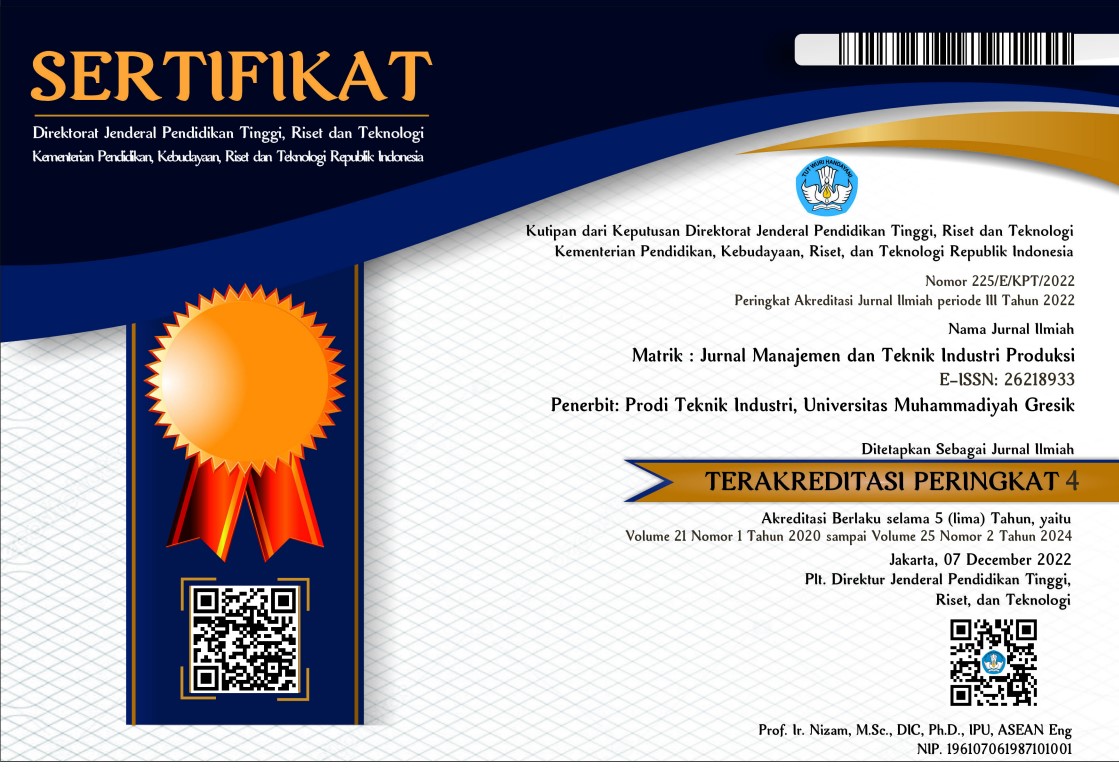RANCANGAN KINERJA SUPPLY CHAIN REMPAH (BAHAN JAMU) KAB. SUMENEP DENGAN PENDEKATAN VALUE STREAM MAPPING
DOI:
https://doi.org/10.30587/matrik.v23i1.3590Keywords:
Cabe Jamu, Jamu Sumenep, Value Stream Mapping, Efisiensi Distribusi; Rantai Pasokan.Abstract
Jamu merupakan suatu produk yang terdiri dari olahan satu bahan atau campuran beberapa tanaman obat yang berfungsi untuk menjaga kesehatan tubuh dan menyembuhkan penyakit pada sistem pengobatan tradisional. Rantai pasokan rempah jamu merupakan suatu konsep sistem pengaturan pada aliran produk, keuangan serta aliran informasi dalam proses distribusi rempah jamu hingga sampai pada konsumen. Dari hasil pemetaan jaringan distribusi menggunakan Value Stream Mapping terdapat 4 alternatif aliran pemasaran rempah jamu di Kabupaten Sumenep. Dari hasil survey diketahui bahwa petani cabe jamu menjual cabe jamu kering ke tengkulak atau pengepul berkisar pada harga Rp. 65.000/kg sampai Rp. 67.000/kg. Karena panjangnya mata rantai pasok distribusi cabe jamu, produk akhir dari penjualan cabe setelah melalui proses produksi yang dilakukan beberapa pengusaha industry jamu sampai mencapai harga Rp.150.000/kg – Rp.160.000/kg sampai pada konsumen akhir. Dari alternatif yang ada, aliran yang memiliki nilai efisiensi pemasaran tertinggi (0.35%) dan Biaya transaksi terendah (Rp. 527/Kg) adalah alternatif aliran ke 2 yaitu ( Petani – Pengepul – Industri Jamu – Konsumen).
References
[2] A. Hasibuan et al., “Performance analysis of Supply Chain Management with Supply Chain Operation reference model,” J. Phys. Conf. Ser., vol. 1007, no. 1, 2018, doi: 10.1088/1742-6596/1007/1/012029.
[3] K. Jagan Mohan Reddy, A. Neelakanteswara Rao, and L. Krishnanand, “A review on supply chain performance measurement systems,” Procedia Manuf., vol. 30, pp. 40–47, 2019, doi: 10.1016/j.promfg.2019.02.007.
[4] M. Munir, M. S. S. Jajja, K. A. Chatha, and S. Farooq, “Supply chain risk management and operational performance: The enabling role of supply chain integration,” Int. J. Prod. Econ., vol. 227, 2020, doi: 10.1016/j.ijpe.2020.107667.
[5] A. Haddud, A. DeSouza, A. Khare, and H. Lee, “Examining potential benefits and challenges associated with the Internet of Things integration in supply chains,” J. Manuf. Technol. Manag., vol. 28, no. 8, pp. 1055–1085, Jan. 2017, doi: 10.1108/JMTM-05-2017-0094.
[6] J. L. García-Alcaraz, V. Martínez-Loya, J. R. Díaz-Reza, J. Blanco-Fernández, E. Jiménez-Macías, and A. J. G. López, “Effect of ICT integration on SC flexibility, agility and company’ performance: the Mexican maquiladora experience,” Wirel. Networks, vol. 26, no. 7, pp. 4805–4818, 2020, doi: 10.1007/s11276-019-02068-6.
[7] A. A. A. Shukor, M. S. Newaz, M. K. Rahman, and A. Z. Taha, “Supply chain integration and its impact on supply chain agility and organizational flexibility in manufacturing firms,” Int. J. Emerg. Mark., no. August, 2020, doi: 10.1108/IJOEM-04-2020-0418.
[8] Z. J. H. Tarigan, J. Mochtar, S. R. Basana, and H. Siagian, “The effect of competency management on organizational performance through supply chain integration and quality,” Uncertain Supply Chain Manag., vol. 9, no. 2, pp. 283–294, 2021, doi: 10.5267/j.uscm.2021.3.004.
[9] T. M. Mofokeng and R. Chinomona, “Supply chain partnership, supply chain collaboration and supply chain integration as the antecedents of supply chain performance,” South African J. Bus. Manag., vol. 50, no. 1, pp. 1–10, 2019, doi: 10.4102/sajbm.v50i1.193.
[10] I. Azmi, N. A. Hamid, M. N. M. Hussin, and N. I. Ibrahim, “Logistics and supply chain management: The importance of integration for business processes,” J. Emerg. Econ. Islam. Res., vol. 5, no. 4, p. 73, 2017, doi: 10.24191/jeeir.v5i4.8838.
[11] S. Padmantyo and A. Saputra, “Peranan manajemen rantai pasokan terhadap kualitas produk dan efisiensi distribusi,” Pros. dalam Semin. Peran Profesi Akunt. Dalam Penanggulangan Korupsi ISSN 2460-0784, no. Seminar Nasional dan The 4th Call for Syariah Paper, pp. 191–197, 2017.
[12] E. Setiawan, “Kajian Hubungan Unsur Iklim Terhadap Produktivitas Cabe Jamu (Piper Retrofractum Vahl) di Kabupaten Sumenep,” Agrovigor, vol. 2, no. 1, pp. 1–7, 2009, [Online]. Available: https://journal.trunojoyo.ac.id/agrovigor/article/view/234/216.
[13] A. Anisah and M. Hayati, “Pengambilan Keputusan Petani untuk Tetap Berusahatani Cabe Jamu di Kecamatan Bluto, Sumenep,” Agrar. J. Agribus. Rural Dev. Res., vol. 3, no. 2, 2017, doi: 10.18196/agr.3251.
[14] I. Fatmawati and A. Destryana, “The prospects of jamu agro-industry as a herbal agribusiness in Sumenep,” E-Proceeding Stie Mandala, pp. 657–668, 2017, [Online]. Available: http://jurnal.stie-mandala.ac.id/index.php/eproceeding/article/view/155.
[15] S. Akhmad, A. Arendra, Mu’Alim, and R. Hidayat, “The communal salt farmer ventures grouping strategy in Sumenep District using the P-Median method to minimize transport distance in food supply chain network.,” J. Phys. Conf. Ser., vol. 1477, no. 5, 2020, doi: 10.1088/1742-6596/1477/5/052063.
[16] K. Winarso, S. Akhmad, R. Hidayat, and A. Arendra, “Determining the location point of aggregation warehouse for salt supply chain,” Proceeding - 6th Inf. Technol. Int. Semin. ITIS 2020, pp. 188–192, 2020, doi: 10.1109/ITIS50118.2020.9320963.
[17] P. Hines, N. Rich, and A. Esain, “Value stream mapping: A distribution industry application,” Benchmarking An Int. J., vol. 6, no. 1, pp. 60–77, 1999, doi: 10.1108/14635779910258157.
[18] A. Rahim and D. R. D. Hastuti, Ekonomika Pertanian: Pengantar, Teori dan Kasus. Jakarta: Penebar Swadaya, 2007.







